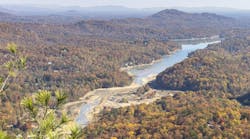
As you might have heard, Cape Town, South Africa, is about to run out of water. Officials have predicted that “Day Zero,” when the water reserves drop so low that they’ll have to shut off the supply to the taps, will occur within the next few months. Despite severe restrictions on use—50 liters per day per person, down from 87 liters—the water level in the reservoirs is still dropping. Once the taps are dry, officials say, residents will be allowed just 25 liters per person per day, which they will have to pick up from collection points around the city. The city is anticipating calling in the military to oversee the process and prevent people from taking more than their share.
Ongoing drought and the city’s growing population are responsible for the shortage. Cape Town, the country’s second-largest city, has about four million people, and the crisis has been disastrous for the economy and the tourist industry. The ideal solution is rain—and, barring that, probably expensive importation of water from elsewhere—but an experiment taking place halfway around the world might offer hope for other cities that someday find themselves in a similar predicament.
Orange County, CA, is launching a project to capture stormwater during the rainy season, rather than letting most of it flow into the ocean as it usually does. Stormwater management strategies often seek to limit runoff, but the purpose is usually to curb flooding and the flow of pollutants rather than to harvest the water for use. Increasingly popular green infrastructure measures, for instance, infiltrate water but do not capture much of the runoff on a large scale. Lot-level measures like rain barrels allow homeowners to capture roof runoff for landscape irrigation, but they’re still limited in scope.
The Santa Margarita Water District in Orange County is hoping for bigger things. It’s proposing to use inflatable dams to capture water from two creeks—initially about 2.8 billion gallons a year, or enough to supply 25,000 families. If approved, the plan, known as the San Juan Watershed project, will use the dams to slow the water and allow it to infiltrate into the San Juan Basin, an underground stream. Treated water from wastewater treatment plants will also be added to the basin. The water district will later pump water from the basin and chemically treat it. Ultimately, the goal is to capture as much as 5.6 billion gallons of water a year. Although other green infrastructure practices can, in fact, help replenish aquifers, this strategy is different in that it will add a quantifiable amount of water to a specific underground source.
Currently, as this article reports, the county imports about 80% of its water supply from either the Colorado River or from the northern part of the state. Another 15% of its water—used for irrigation—is recycled from treatment plants, and 5% comes from local groundwater supplies.
An article coming up in the May issue of Stormwater will consider the benefits and drawbacks of rainwater harvesting, as well as the problems drought can cause for wastewater treatment plants—and for the quality of recycled water—when stringent conservation measures limit the flow of wastewater.
You can read more about the San Juan Watershed project here.
About the Author
Janice Kaspersen
Janice Kaspersen is the former editor of Erosion Control and Stormwater magazines.

